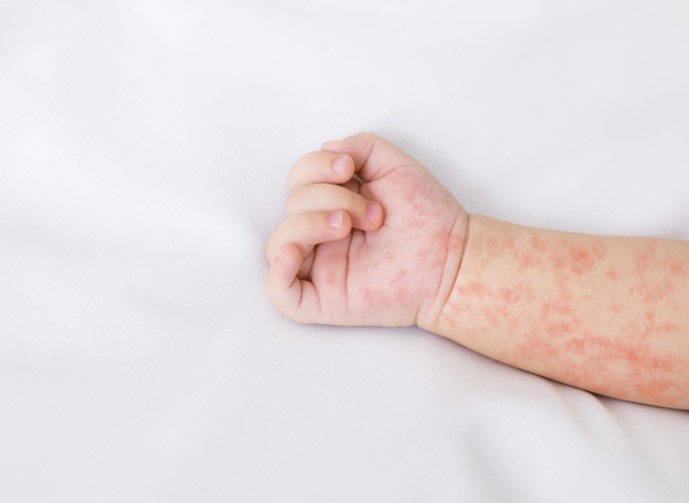Measles
Measles (rubeola) is a disease caused by a virus that spreads very easily from person to person.
It disperses when an infected individual coughs or sneezes, and the virus can survive on surfaces or in tiny droplets in the air for up to two hours afterward.
Measles can cause serious complications, and about 20% of people in the United States who contract measles will require hospitalization.
Even with modern medical care, about one person in 1000 who contracts measles will die from the disease.
HISTORY
Measles has been known in medicine since the 9th century.
In 1912, hospitals and doctors began to be required to report measles cases, and this new policy revealed that the virus killed more than 5,000 people in the United States annually.
During the 1950s, most people caught the virus during childhood; many as four million Americans were infected each year.
Scientists realized during the 1700s that something carried in the blood caused the disease, and in 1954 researchers managed to successfully isolate the virus in the blood of a boy from the Boston area who caught it during a measles outbreak.
This success led to the development of two vaccines, one that began being used in 1964 and a second, weaker vaccine developed in 1968.
The 1968 vaccine is still used in the United States as part of the MMR vaccine (measles, mumps, rubella).
SIGNS AND SYMPTOMS
The first signs of measles can be mistaken for other ailments.
Symptoms include:
- Cough
- Runny nose
- Red, watery eyes
- High fever, sometimes over 104°F
These signs commonly appear a week or two after the person has been exposed to the virus. The virus is transmissible to others before symptoms appear.
Another sign of measles that can appear shortly after these initial symptoms is white spots in the mouth. These Koplik spots show up two or three days after the symptoms listed above.
The rash that is typical of measles appears three to five days after the first symptoms.
It consists of flat red spots that appear first at the hairline and spread downward, covering the face, torso, arms and legs, and feet. High fever can accompany the rash.
COMPLICATIONS
Most serious complications from measles occur in people under age 5 or over age 20, as well as in people who are pregnant or who have compromised immune systems.
Complications include:
- Diarrhea
- Ear infections, which may result in permanent hearing loss
- Pneumonia
- Encephalitis, or swelling of the brain
About 1 in 10 children who contract measles experience ear infections, and about 1 in 20 contract pneumonia, which is the most common cause of death among young children.
Encephalitis, which develops in 1 of every 1,000 cases, can cause seizures and intellectual disability or hearing loss.
Someone pregnant who contracts measles may deliver prematurely, or the baby may have a low birth weight.
Another complication from measles can occur years after the illness: subacute sclerosing panencephalitis (SSPE).
This progressive disease strikes from seven to 10 years after the person recovers from measles.
Symptoms may include behavior changes and difficulties with thinking, memory, judgment, and language.
As SSPE progresses, the person may experience uncontrollable jerking movements of the limbs or body (myoclonic jerks) or other movement problems, such as trouble walking.
SSPE cannot be treated and is always fatal. Less than ten cases of SSPE are reported in the United States each year;
the risk of contracting SSPE is higher in India and Eastern European nations and lower in nations with a widespread program of measles vaccination.
CASES AND OUTBREAKS
Although measles vaccines protect many people, there are pockets of nonvaccinated people worldwide, and other nations may have lower rates of vaccination than the United States.
As a result, measles cases still occur in the United States, and many states experience outbreaks or sudden increases in cases.
Between January 1 and November 7, 2019, there were 1,261 cases in the United States, the highest number of cases since 1992.
Of that number, 123 were hospitalized, and 61 experienced complications. Most of those cases were in people who had not been vaccinated.
Three-quarters of the 2019 total was connected to an outbreak in New York City that began in October 2018 and ran through August 2019. Health officials declared the outbreak over on September 3, 2019.
During the outbreak, 649 people contracted measles; most of them were people under age 17 who had not been vaccinated.
Other states that experienced measles outbreaks in 2019 were California, Georgia, Illinois, Michigan, New Jersey, Oregon, Pennsylvania, Texas, and Washington.
Globally, measles killed 2.3 million people each year before the vaccine was introduced n 1963.
The World Health Organization assesses that between 2000 and 2017, vaccinations saved more than 20 million lives.
TREATMENT
Since a virus generates measles, antibiotics are not effective against the disease. Supportive treatment includes rest, fluids, and fever reducers.
After measles is diagnosed, the best thing to do is to stay home; that way, you reduce the chance of spreading measles to others.
Use a tissue to cover your mouth and nose when you sneeze or cough and put the tissue in a trash can.
Wash your hands often, and avoid sharing glasses, cups, or eating utensils with other people.
Kill viruses present on surfaces with a household disinfectant to prevent the further spread of the illness. Children with severe cases are sometimes treated with vitamin A.
PREVENTION
A vaccine can prevent measles. The measles vaccine teaches the body to recognize and fight the measles virus.
The body produces antibodies that will identify any measles virus they encounter and signal the immune system to take action.
It takes two or three weeks for the vaccine to be fully effective.
The Centers for Disease Control recommend one measles vaccine between 12 and 15 months, and the next between ages 4 and 6.
The second dose can be administered earlier, but not sooner than 28 days after the first.
In 1994, the federal government began a program that provided vaccinations to children whose families would otherwise have been unable to afford them. As a result, the vaccine coverage of children under the age of three is nearly 93 percent.
Nationwide, the CDC monitors the number of kindergartners who have been vaccinated against measles and how many have received exemptions from vaccination.
An exemption means that a parent may have refused one particular dose of vaccine for their child, refused all in a series of a particular vaccine, or refused all vaccines.
Across the country, approximately 95 percent of kindergartners had received their MMR vaccines during the 2018-19 school year.
Measles is still prevalent in other regions of the world, causing 110,000 deaths each year, particularly among children under age 5.
Travelers can be exposed to the disease and carry it home with them.
If you plan to travel to a part of the world where measles is common, you should determine if you are immune to measles.
Here is how to be sure:
- Born before 1957 in the United States
- Documentation of vaccinations
- Laboratory evidence of immunity
- Laboratory confirmation of having had measles
If nothing of the above applies, it is possible to get the MMR vaccine, two doses, 28 days apart.
Talk to your healthcare provider to make certain.
Resources
Websites
Gibney, Katherine. “Measles in Samoa: how a small island nation found itself in the grips of an outbreak disaster.” December 11, 2019. https://theconversation.com/measles-in-samoa-how-a-small-island-nation-found-itself-in-the-grips-of-an-outbreak-disaster-128467 (accessed February 13, 2020).
“Measles.” Doctors Without Borders—the USA. https://www.doctorswithoutborders.org/what-we-do/medical-issues/measles (accessed February 13, 2020).
“Measles.” Mayo Clinic. May 24, 2019. https://www.mayoclinic.org/diseases-conditions/measles/symptoms-causes/syc-20374857 (accessed February 13, 2020).
“Measles (Rubeola).” Centers for Disease Control and Prevention. October 4, 2019. https://www.cdc.gov/measles/index.html (accessed February 13, 2020).
“Measles and Adolescents.” National Foundation for Infectious Diseases. https://www.nfid.org/infectious-diseases/measles-and-adolescents (accessed February 13, 2020).
“More than 140,000 die from measles as cases surge worldwide.” World Health Organization. December 5, 2019. https://www.who.int/news-room/detail/05-12-2019-more-than-140-000-die-from-measles-as-cases-surge-worldwide (accessed February 13, 2020).
Organizations
American Academy of Pediatrics, 345 Park Boulevard, Itasca, IL, 60143, (800) 433-9016, https://www.aap.org.
Centers for Disease Control and Prevention (CDC), 1600 Clifton Road, Atlanta, GA, 30333, (800) 232-4636, cdcinfo@cdc.gov, http://www.cdc.gov .
World Health Organization (WHO), Avenue Appia 20, 1211 Geneva 27, Switzerland, +41 22 791 21 11, Fax: +41 22 791 31 11, info@who.int, http://www.who.int/en .








